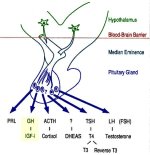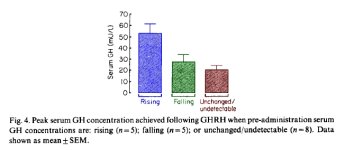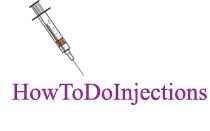Seromrelin (
+) is
GHRH (Growth Hormone Releasing Hormone). It is opposed by the hormone
Somatostatin (
-)
Because
GHRH travels a short distance from the Hypothalamus to the adjacent Pituitary,
GHRH endogenous release is effective. The vulnerability is limited and plasma degradation is of no consequence.
But exogenous administration is not extremely effective.
It has been demonstrated that degradation at the site of injection of
GHRH after subcutaneous administration is extremely rapid. The estimated amount in the circulation after subcutaneous injection was only 4% of that obtained after intravenous administration.
*
It is rapidly metabolized in the plasma, as a result of the Ala-Asp (at the 2nd & 3rd position respectively) peptide bond cleavage by dipeptidylpeptidase IV leading to the inactive Growth Hormone Releasing Fragment of amino acids 3–29.
**
As a consequence those clinical studies that show longer term benefit and elevated GH & IGF-1 rely on
Sermorelin dosages measured in milligrams not micrograms.
Therefore analogs of
GHRH have been created that decrease the vulnerability of
GHRH in plasma. In particular an amino-acid substitution is made at the 2nd position to reduce the very quick cleavage that normally would occur.
One such analog is what I call
modified GRF(1-29). Because of 5 amino acid substitutions it will not rapidly metabolize in plasma and will make its way to the pituitary where it will effect growth hormone release.
Now Dr. Crisler who posts here and in this thread as Swale found in his clinical practice that when he added
GHRP-6 to
Sermorelin his patients experienced a 1/3 increase in IGF-1 over a
Sermorelin only protocol.
So aside from degradation issues, if you don't use a Growth Hormone Releasing Peptide such as
GHRP-6 or
GHRP-2 with the
GHRH then you will have inconsistent GH pulses.
Growth Hormone Releasing Peptides are modulating peptides (analogs of the hormone
Ghrelin). They bind to their own receptor in the hypothalamus & pituitary and they initiate a GH pulse (or wave). They do this in part by minimizing the influence of the inhibiting hormone,
Somatostatin (
-) and increasing the influence of the positive hormone
GHRH (
+), in addition to their own distinct action of effecting GH release from cells in the pituitary.
There is synergy (i.e. more than additive) in GH release when both
GHRH & a
GHRP are administered together. But in addition there is consistency & predictability when a
GHRP is added because it will initiate a fresh GH pulse (in large part by inhibiting the "off switch",
Somatostatin).
So what happens if you administer
GHRH or
Sermorelin alone?
Remember that naturally GH release is pulsatile. Sometimes there is a big pulse, sometimes a little pulse and sometimes no pulse.
Exogenously administered
GHRH administered during a naturally occurring GH trough results in low amounts of GH release while
GHRH administered during a rising natural GH pulse will result in high amounts of GH release. See:
View attachment 25057
The Interaction Between Clonidine And Growth Hormone Releasing Hormone In The Stimulation Of Growth Hormone Secretion In Man, D. Suri, Clinical Endocrinology (1990), 33, 399-406
* - Rafferty B, Poole S, Clarke R, Shulster D., Growth hormone-releasing factor analogue (hGRF1-29NH2): immunoreactive-GRF plasma levels after intravenous and subcutaneous administration, J. Endocrinol. 1985; 107: R5–R8.
** - Frohman LA, Downs TR, Williams TC, Heimer EP, Pan Y-CE, Felix AM, Dipeptidylpeptidase IV and trypsin-like enzymatic degradation of human growth hormone-releasing hormone in plasma, J. Clin. Invest. 1986; 78: 906–913.




















































































